Impact of Digital Technologies on Business Operations: Marks & Spencer
VerifiedAdded on 2024/06/04
|28
|5163
|299
Report
AI Summary
This report assesses the impact of digital technologies on Marks and Spencer's business operations. It begins by outlining the project's aims and objectives, including inspecting the types of digital technologies used, identifying their implications, and spotting associated challenges and opportunities. A project management plan is presented, covering cost, scope, time, quality, communication, risk, and resources, along with a work breakdown structure and Gantt chart for timeframes. The research employs both qualitative and quantitative methods, using questionnaires and interviews to gather data from employees and managers. Data analysis is conducted, and recommendations are made based on the findings. The report concludes with a reflection on the value of the research and its contribution to learning and performance. Desklib provides more solved assignments and past papers.
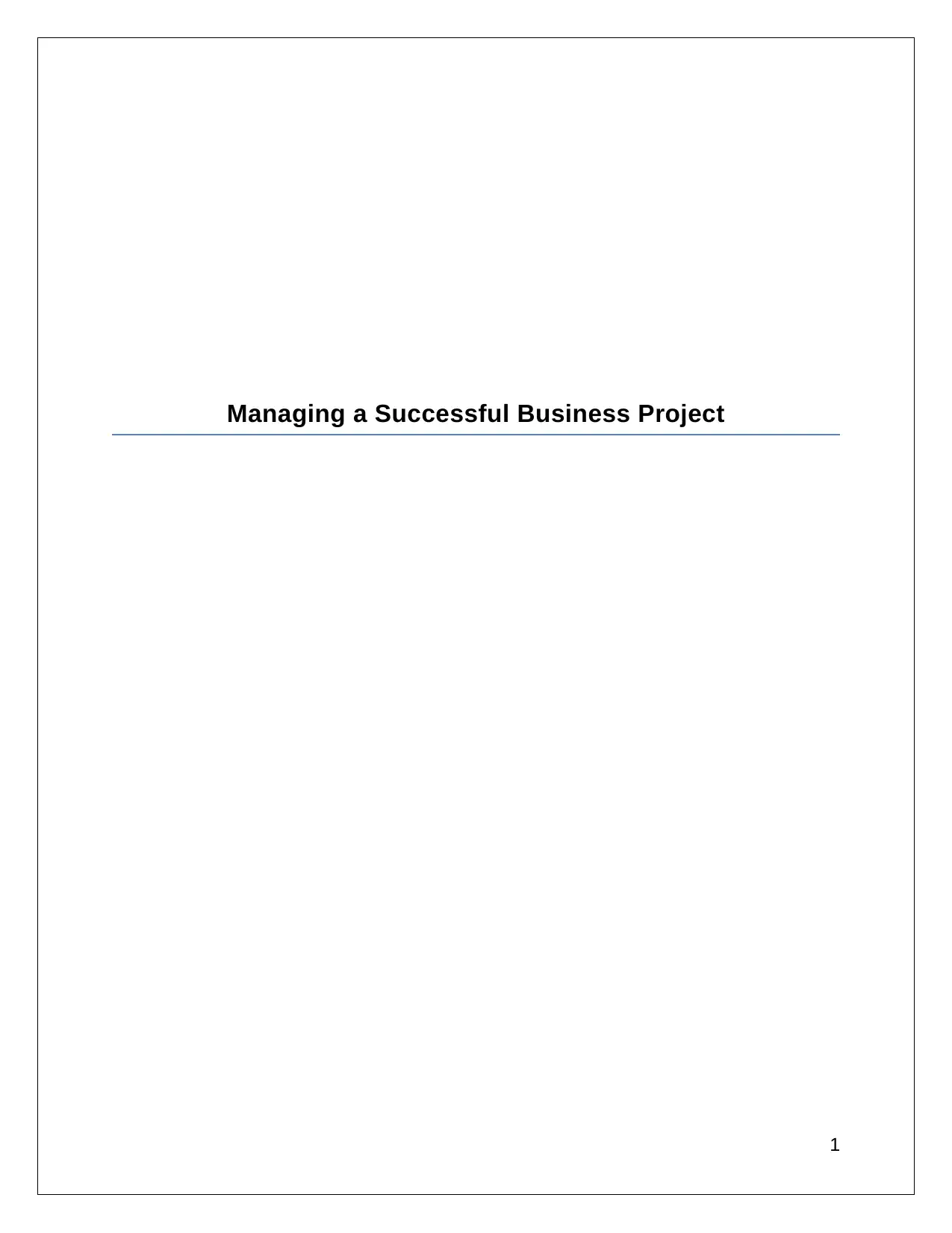
Managing a Successful Business Project
1
1
Paraphrase This Document
Need a fresh take? Get an instant paraphrase of this document with our AI Paraphraser
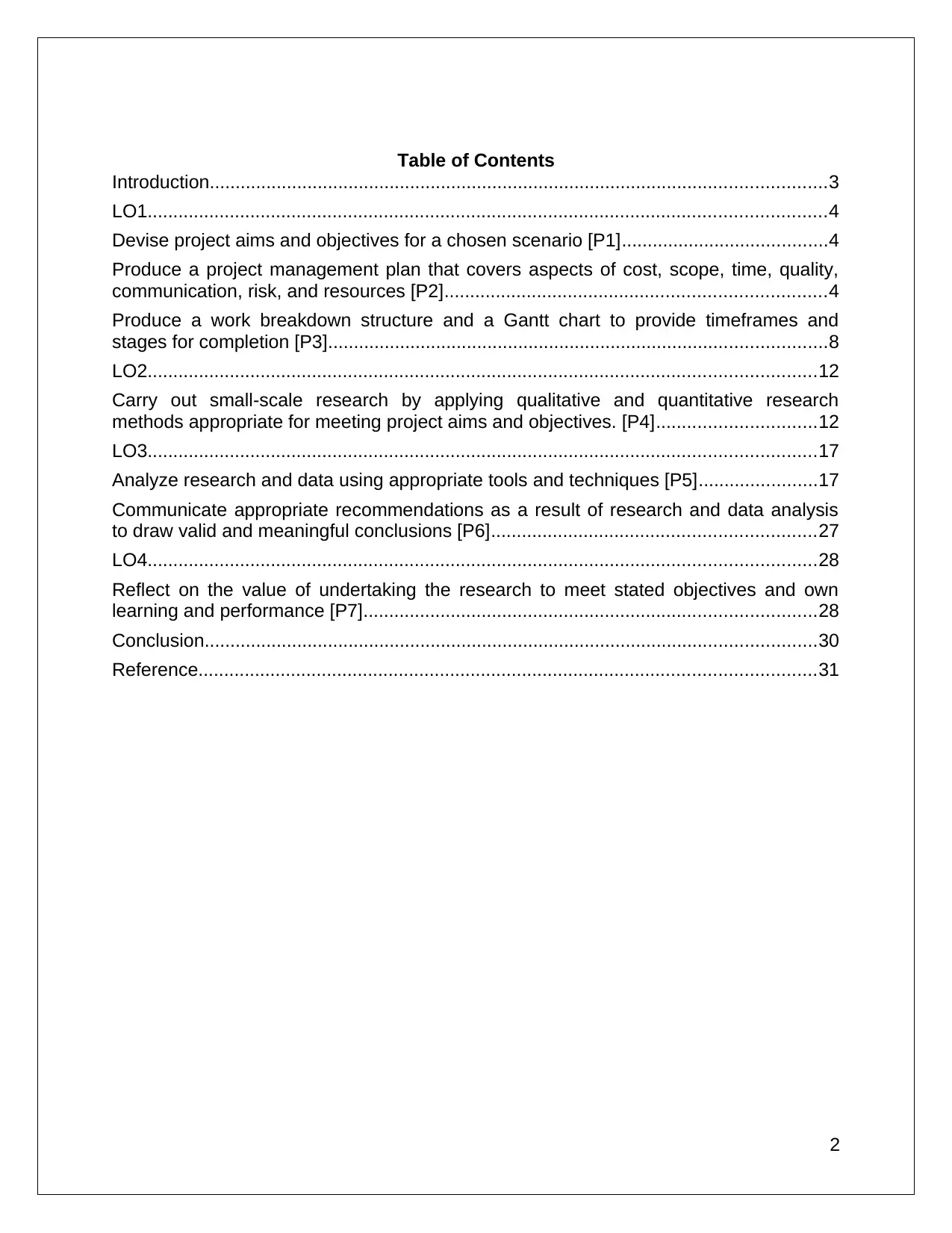
Table of Contents
Introduction........................................................................................................................3
LO1....................................................................................................................................4
Devise project aims and objectives for a chosen scenario [P1]........................................4
Produce a project management plan that covers aspects of cost, scope, time, quality,
communication, risk, and resources [P2]..........................................................................4
Produce a work breakdown structure and a Gantt chart to provide timeframes and
stages for completion [P3].................................................................................................8
LO2..................................................................................................................................12
Carry out small-scale research by applying qualitative and quantitative research
methods appropriate for meeting project aims and objectives. [P4]...............................12
LO3..................................................................................................................................17
Analyze research and data using appropriate tools and techniques [P5].......................17
Communicate appropriate recommendations as a result of research and data analysis
to draw valid and meaningful conclusions [P6]...............................................................27
LO4..................................................................................................................................28
Reflect on the value of undertaking the research to meet stated objectives and own
learning and performance [P7]........................................................................................28
Conclusion.......................................................................................................................30
Reference........................................................................................................................31
2
Introduction........................................................................................................................3
LO1....................................................................................................................................4
Devise project aims and objectives for a chosen scenario [P1]........................................4
Produce a project management plan that covers aspects of cost, scope, time, quality,
communication, risk, and resources [P2]..........................................................................4
Produce a work breakdown structure and a Gantt chart to provide timeframes and
stages for completion [P3].................................................................................................8
LO2..................................................................................................................................12
Carry out small-scale research by applying qualitative and quantitative research
methods appropriate for meeting project aims and objectives. [P4]...............................12
LO3..................................................................................................................................17
Analyze research and data using appropriate tools and techniques [P5].......................17
Communicate appropriate recommendations as a result of research and data analysis
to draw valid and meaningful conclusions [P6]...............................................................27
LO4..................................................................................................................................28
Reflect on the value of undertaking the research to meet stated objectives and own
learning and performance [P7]........................................................................................28
Conclusion.......................................................................................................................30
Reference........................................................................................................................31
2
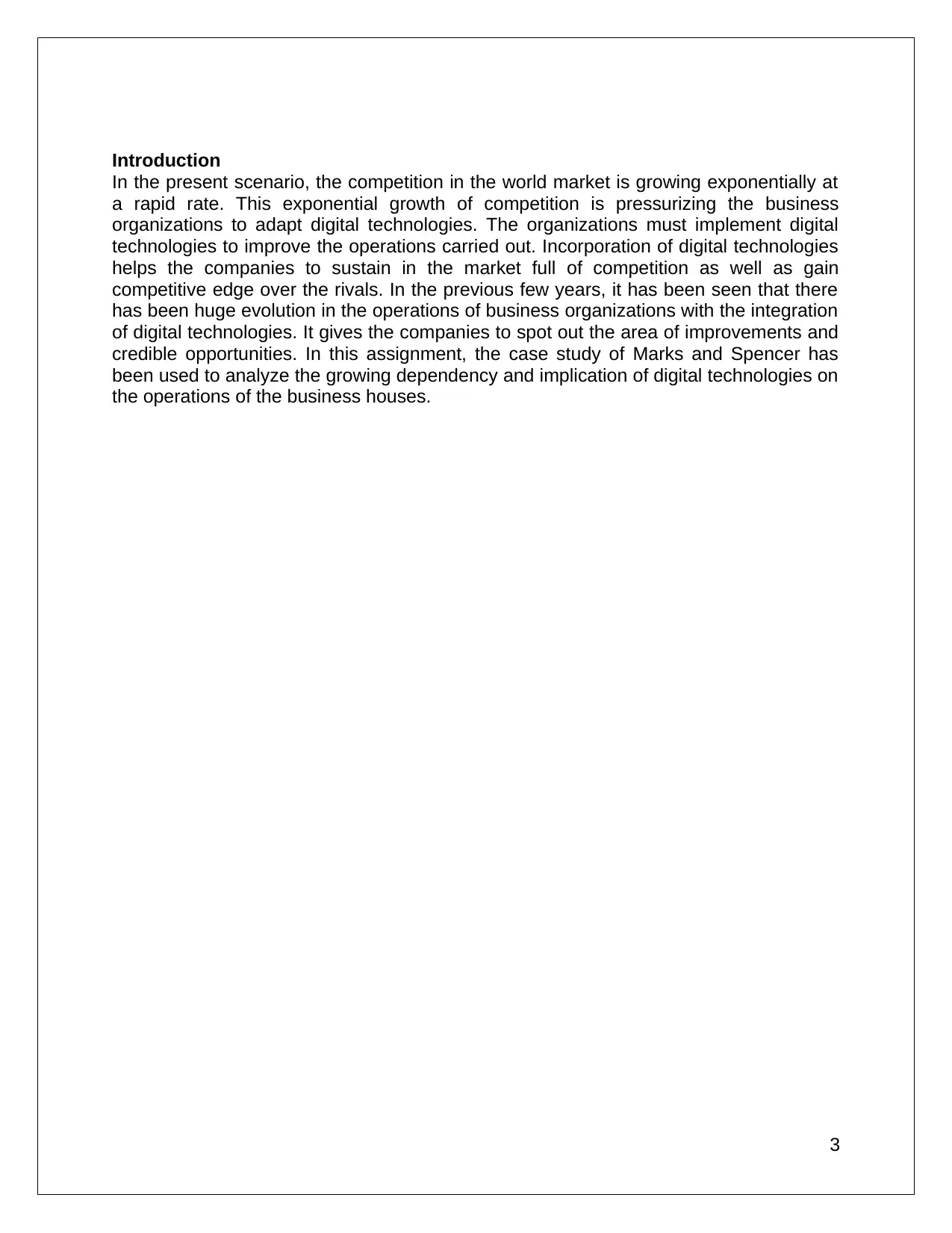
Introduction
In the present scenario, the competition in the world market is growing exponentially at
a rapid rate. This exponential growth of competition is pressurizing the business
organizations to adapt digital technologies. The organizations must implement digital
technologies to improve the operations carried out. Incorporation of digital technologies
helps the companies to sustain in the market full of competition as well as gain
competitive edge over the rivals. In the previous few years, it has been seen that there
has been huge evolution in the operations of business organizations with the integration
of digital technologies. It gives the companies to spot out the area of improvements and
credible opportunities. In this assignment, the case study of Marks and Spencer has
been used to analyze the growing dependency and implication of digital technologies on
the operations of the business houses.
3
In the present scenario, the competition in the world market is growing exponentially at
a rapid rate. This exponential growth of competition is pressurizing the business
organizations to adapt digital technologies. The organizations must implement digital
technologies to improve the operations carried out. Incorporation of digital technologies
helps the companies to sustain in the market full of competition as well as gain
competitive edge over the rivals. In the previous few years, it has been seen that there
has been huge evolution in the operations of business organizations with the integration
of digital technologies. It gives the companies to spot out the area of improvements and
credible opportunities. In this assignment, the case study of Marks and Spencer has
been used to analyze the growing dependency and implication of digital technologies on
the operations of the business houses.
3
⊘ This is a preview!⊘
Do you want full access?
Subscribe today to unlock all pages.

Trusted by 1+ million students worldwide
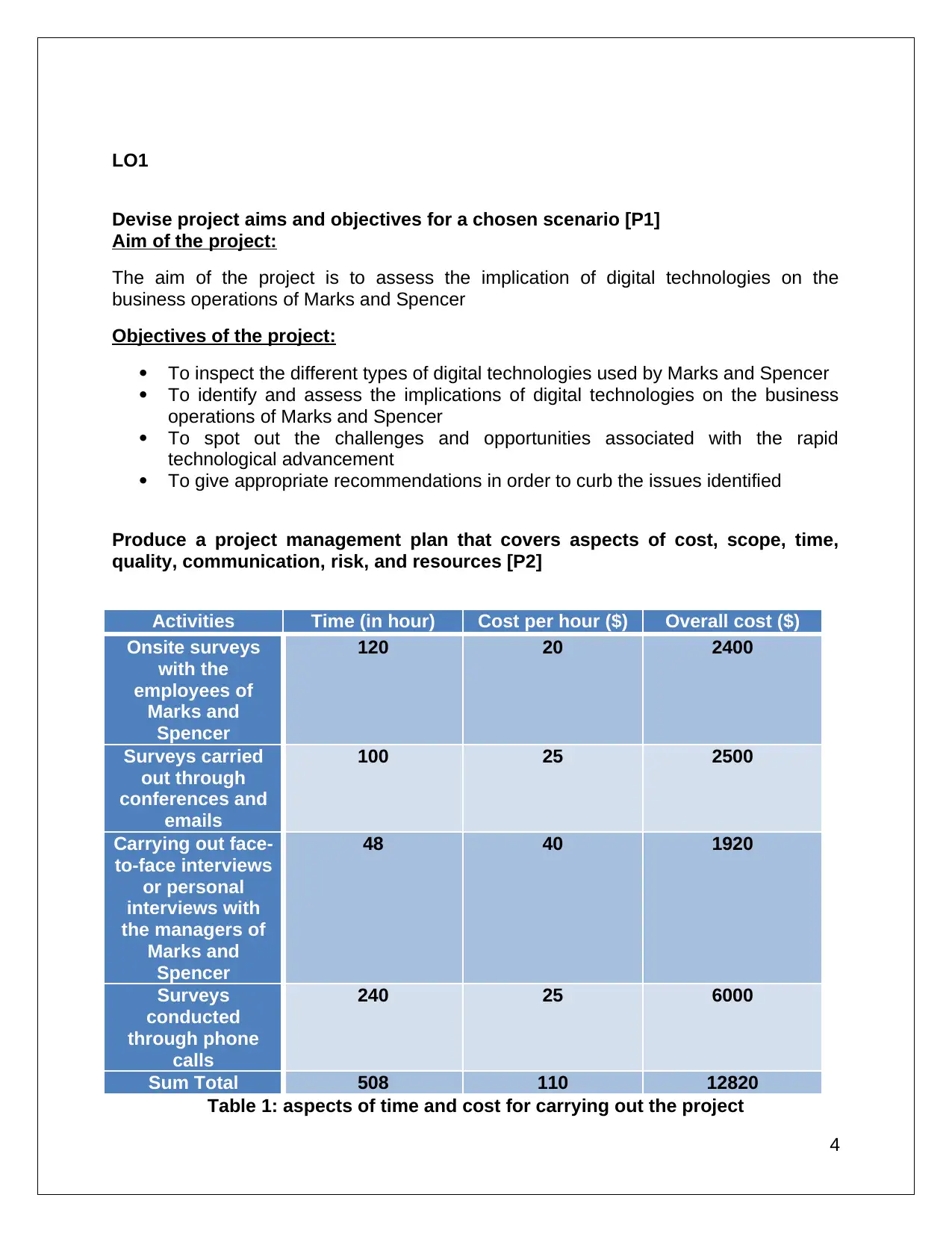
LO1
Devise project aims and objectives for a chosen scenario [P1]
Aim of the project:
The aim of the project is to assess the implication of digital technologies on the
business operations of Marks and Spencer
Objectives of the project:
To inspect the different types of digital technologies used by Marks and Spencer
To identify and assess the implications of digital technologies on the business
operations of Marks and Spencer
To spot out the challenges and opportunities associated with the rapid
technological advancement
To give appropriate recommendations in order to curb the issues identified
Produce a project management plan that covers aspects of cost, scope, time,
quality, communication, risk, and resources [P2]
Activities Time (in hour) Cost per hour ($) Overall cost ($)
Onsite surveys
with the
employees of
Marks and
Spencer
120 20 2400
Surveys carried
out through
conferences and
emails
100 25 2500
Carrying out face-
to-face interviews
or personal
interviews with
the managers of
Marks and
Spencer
48 40 1920
Surveys
conducted
through phone
calls
240 25 6000
Sum Total 508 110 12820
Table 1: aspects of time and cost for carrying out the project
4
Devise project aims and objectives for a chosen scenario [P1]
Aim of the project:
The aim of the project is to assess the implication of digital technologies on the
business operations of Marks and Spencer
Objectives of the project:
To inspect the different types of digital technologies used by Marks and Spencer
To identify and assess the implications of digital technologies on the business
operations of Marks and Spencer
To spot out the challenges and opportunities associated with the rapid
technological advancement
To give appropriate recommendations in order to curb the issues identified
Produce a project management plan that covers aspects of cost, scope, time,
quality, communication, risk, and resources [P2]
Activities Time (in hour) Cost per hour ($) Overall cost ($)
Onsite surveys
with the
employees of
Marks and
Spencer
120 20 2400
Surveys carried
out through
conferences and
emails
100 25 2500
Carrying out face-
to-face interviews
or personal
interviews with
the managers of
Marks and
Spencer
48 40 1920
Surveys
conducted
through phone
calls
240 25 6000
Sum Total 508 110 12820
Table 1: aspects of time and cost for carrying out the project
4
Paraphrase This Document
Need a fresh take? Get an instant paraphrase of this document with our AI Paraphraser
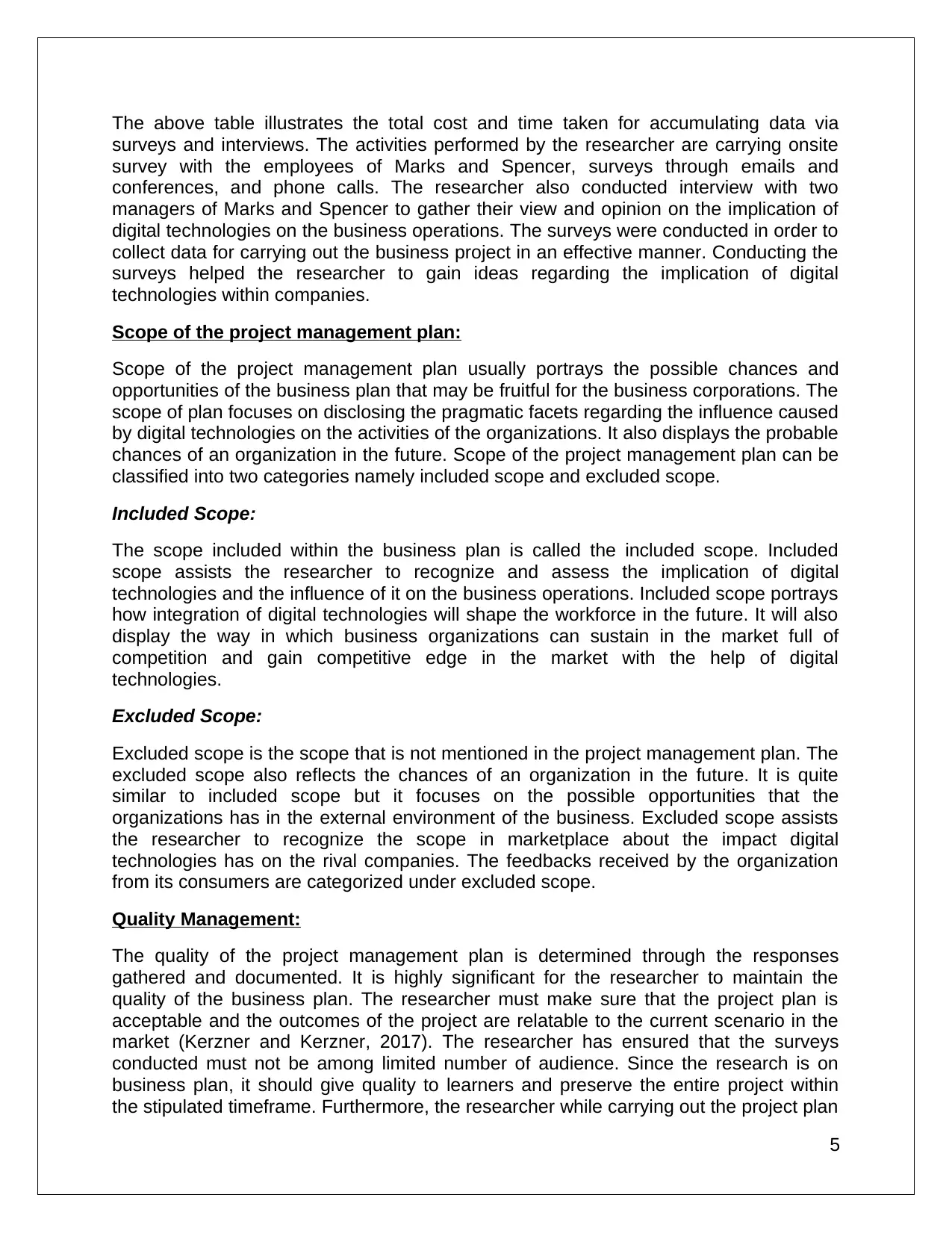
The above table illustrates the total cost and time taken for accumulating data via
surveys and interviews. The activities performed by the researcher are carrying onsite
survey with the employees of Marks and Spencer, surveys through emails and
conferences, and phone calls. The researcher also conducted interview with two
managers of Marks and Spencer to gather their view and opinion on the implication of
digital technologies on the business operations. The surveys were conducted in order to
collect data for carrying out the business project in an effective manner. Conducting the
surveys helped the researcher to gain ideas regarding the implication of digital
technologies within companies.
Scope of the project management plan:
Scope of the project management plan usually portrays the possible chances and
opportunities of the business plan that may be fruitful for the business corporations. The
scope of plan focuses on disclosing the pragmatic facets regarding the influence caused
by digital technologies on the activities of the organizations. It also displays the probable
chances of an organization in the future. Scope of the project management plan can be
classified into two categories namely included scope and excluded scope.
Included Scope:
The scope included within the business plan is called the included scope. Included
scope assists the researcher to recognize and assess the implication of digital
technologies and the influence of it on the business operations. Included scope portrays
how integration of digital technologies will shape the workforce in the future. It will also
display the way in which business organizations can sustain in the market full of
competition and gain competitive edge in the market with the help of digital
technologies.
Excluded Scope:
Excluded scope is the scope that is not mentioned in the project management plan. The
excluded scope also reflects the chances of an organization in the future. It is quite
similar to included scope but it focuses on the possible opportunities that the
organizations has in the external environment of the business. Excluded scope assists
the researcher to recognize the scope in marketplace about the impact digital
technologies has on the rival companies. The feedbacks received by the organization
from its consumers are categorized under excluded scope.
Quality Management:
The quality of the project management plan is determined through the responses
gathered and documented. It is highly significant for the researcher to maintain the
quality of the business plan. The researcher must make sure that the project plan is
acceptable and the outcomes of the project are relatable to the current scenario in the
market (Kerzner and Kerzner, 2017). The researcher has ensured that the surveys
conducted must not be among limited number of audience. Since the research is on
business plan, it should give quality to learners and preserve the entire project within
the stipulated timeframe. Furthermore, the researcher while carrying out the project plan
5
surveys and interviews. The activities performed by the researcher are carrying onsite
survey with the employees of Marks and Spencer, surveys through emails and
conferences, and phone calls. The researcher also conducted interview with two
managers of Marks and Spencer to gather their view and opinion on the implication of
digital technologies on the business operations. The surveys were conducted in order to
collect data for carrying out the business project in an effective manner. Conducting the
surveys helped the researcher to gain ideas regarding the implication of digital
technologies within companies.
Scope of the project management plan:
Scope of the project management plan usually portrays the possible chances and
opportunities of the business plan that may be fruitful for the business corporations. The
scope of plan focuses on disclosing the pragmatic facets regarding the influence caused
by digital technologies on the activities of the organizations. It also displays the probable
chances of an organization in the future. Scope of the project management plan can be
classified into two categories namely included scope and excluded scope.
Included Scope:
The scope included within the business plan is called the included scope. Included
scope assists the researcher to recognize and assess the implication of digital
technologies and the influence of it on the business operations. Included scope portrays
how integration of digital technologies will shape the workforce in the future. It will also
display the way in which business organizations can sustain in the market full of
competition and gain competitive edge in the market with the help of digital
technologies.
Excluded Scope:
Excluded scope is the scope that is not mentioned in the project management plan. The
excluded scope also reflects the chances of an organization in the future. It is quite
similar to included scope but it focuses on the possible opportunities that the
organizations has in the external environment of the business. Excluded scope assists
the researcher to recognize the scope in marketplace about the impact digital
technologies has on the rival companies. The feedbacks received by the organization
from its consumers are categorized under excluded scope.
Quality Management:
The quality of the project management plan is determined through the responses
gathered and documented. It is highly significant for the researcher to maintain the
quality of the business plan. The researcher must make sure that the project plan is
acceptable and the outcomes of the project are relatable to the current scenario in the
market (Kerzner and Kerzner, 2017). The researcher has ensured that the surveys
conducted must not be among limited number of audience. Since the research is on
business plan, it should give quality to learners and preserve the entire project within
the stipulated timeframe. Furthermore, the researcher while carrying out the project plan
5
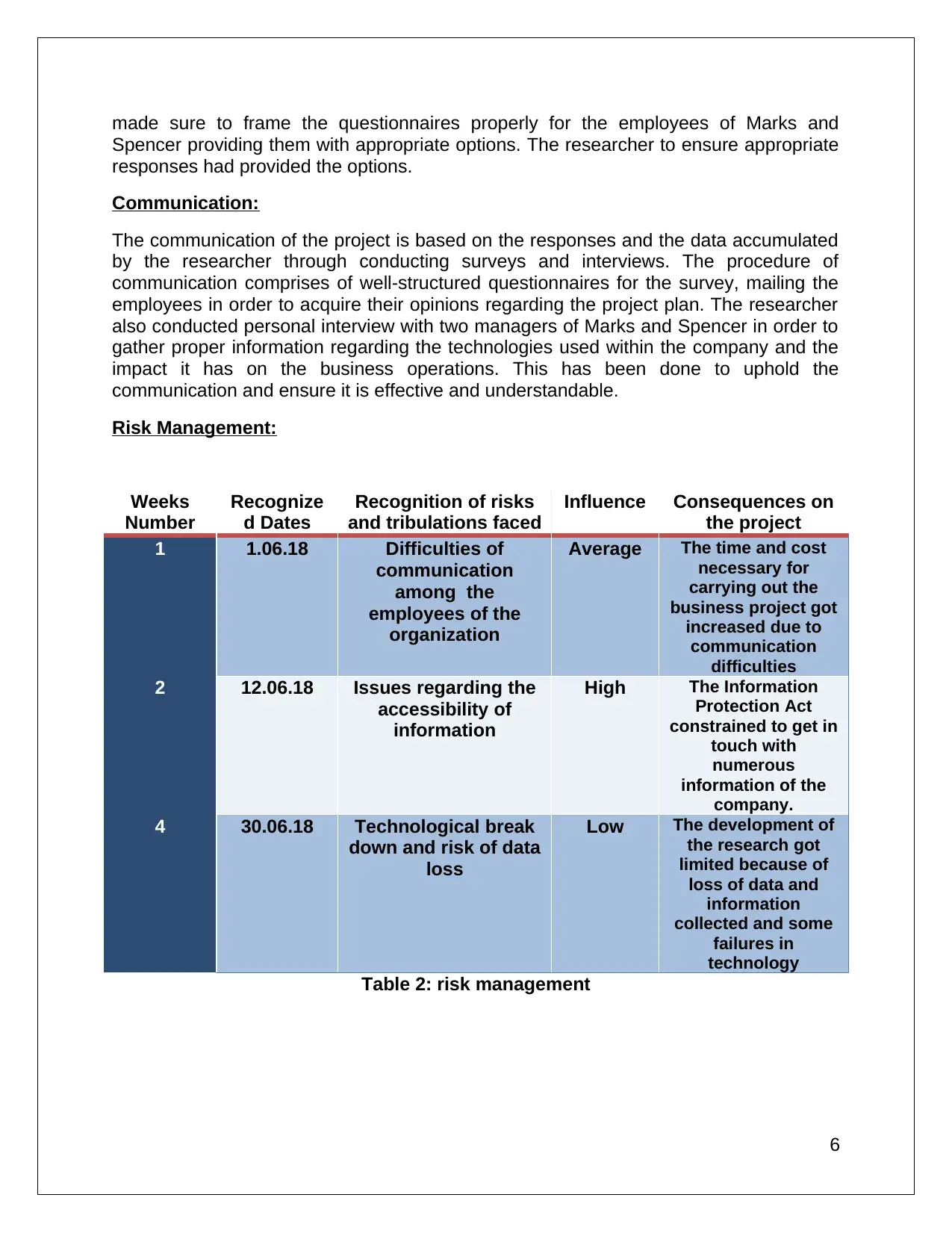
made sure to frame the questionnaires properly for the employees of Marks and
Spencer providing them with appropriate options. The researcher to ensure appropriate
responses had provided the options.
Communication:
The communication of the project is based on the responses and the data accumulated
by the researcher through conducting surveys and interviews. The procedure of
communication comprises of well-structured questionnaires for the survey, mailing the
employees in order to acquire their opinions regarding the project plan. The researcher
also conducted personal interview with two managers of Marks and Spencer in order to
gather proper information regarding the technologies used within the company and the
impact it has on the business operations. This has been done to uphold the
communication and ensure it is effective and understandable.
Risk Management:
Weeks
Number
Recognize
d Dates
Recognition of risks
and tribulations faced
Influence Consequences on
the project
1 1.06.18 Difficulties of
communication
among the
employees of the
organization
Average The time and cost
necessary for
carrying out the
business project got
increased due to
communication
difficulties
2 12.06.18 Issues regarding the
accessibility of
information
High The Information
Protection Act
constrained to get in
touch with
numerous
information of the
company.
4 30.06.18 Technological break
down and risk of data
loss
Low The development of
the research got
limited because of
loss of data and
information
collected and some
failures in
technology
Table 2: risk management
6
Spencer providing them with appropriate options. The researcher to ensure appropriate
responses had provided the options.
Communication:
The communication of the project is based on the responses and the data accumulated
by the researcher through conducting surveys and interviews. The procedure of
communication comprises of well-structured questionnaires for the survey, mailing the
employees in order to acquire their opinions regarding the project plan. The researcher
also conducted personal interview with two managers of Marks and Spencer in order to
gather proper information regarding the technologies used within the company and the
impact it has on the business operations. This has been done to uphold the
communication and ensure it is effective and understandable.
Risk Management:
Weeks
Number
Recognize
d Dates
Recognition of risks
and tribulations faced
Influence Consequences on
the project
1 1.06.18 Difficulties of
communication
among the
employees of the
organization
Average The time and cost
necessary for
carrying out the
business project got
increased due to
communication
difficulties
2 12.06.18 Issues regarding the
accessibility of
information
High The Information
Protection Act
constrained to get in
touch with
numerous
information of the
company.
4 30.06.18 Technological break
down and risk of data
loss
Low The development of
the research got
limited because of
loss of data and
information
collected and some
failures in
technology
Table 2: risk management
6
⊘ This is a preview!⊘
Do you want full access?
Subscribe today to unlock all pages.

Trusted by 1+ million students worldwide
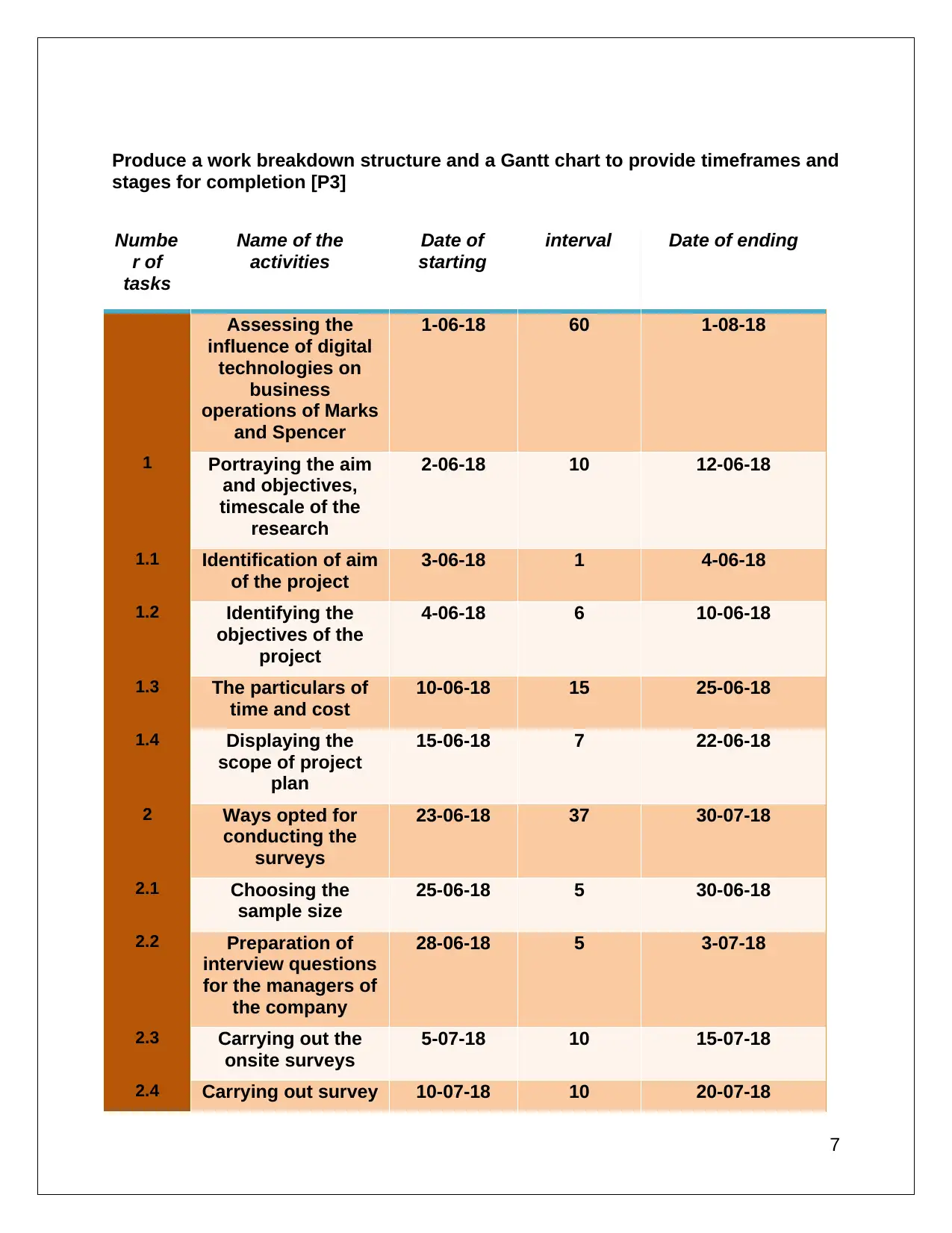
Produce a work breakdown structure and a Gantt chart to provide timeframes and
stages for completion [P3]
Numbe
r of
tasks
Name of the
activities
Date of
starting
interval Date of ending
Assessing the
influence of digital
technologies on
business
operations of Marks
and Spencer
1-06-18 60 1-08-18
1 Portraying the aim
and objectives,
timescale of the
research
2-06-18 10 12-06-18
1.1 Identification of aim
of the project
3-06-18 1 4-06-18
1.2 Identifying the
objectives of the
project
4-06-18 6 10-06-18
1.3 The particulars of
time and cost
10-06-18 15 25-06-18
1.4 Displaying the
scope of project
plan
15-06-18 7 22-06-18
2 Ways opted for
conducting the
surveys
23-06-18 37 30-07-18
2.1 Choosing the
sample size
25-06-18 5 30-06-18
2.2 Preparation of
interview questions
for the managers of
the company
28-06-18 5 3-07-18
2.3 Carrying out the
onsite surveys
5-07-18 10 15-07-18
2.4 Carrying out survey 10-07-18 10 20-07-18
7
stages for completion [P3]
Numbe
r of
tasks
Name of the
activities
Date of
starting
interval Date of ending
Assessing the
influence of digital
technologies on
business
operations of Marks
and Spencer
1-06-18 60 1-08-18
1 Portraying the aim
and objectives,
timescale of the
research
2-06-18 10 12-06-18
1.1 Identification of aim
of the project
3-06-18 1 4-06-18
1.2 Identifying the
objectives of the
project
4-06-18 6 10-06-18
1.3 The particulars of
time and cost
10-06-18 15 25-06-18
1.4 Displaying the
scope of project
plan
15-06-18 7 22-06-18
2 Ways opted for
conducting the
surveys
23-06-18 37 30-07-18
2.1 Choosing the
sample size
25-06-18 5 30-06-18
2.2 Preparation of
interview questions
for the managers of
the company
28-06-18 5 3-07-18
2.3 Carrying out the
onsite surveys
5-07-18 10 15-07-18
2.4 Carrying out survey 10-07-18 10 20-07-18
7
Paraphrase This Document
Need a fresh take? Get an instant paraphrase of this document with our AI Paraphraser
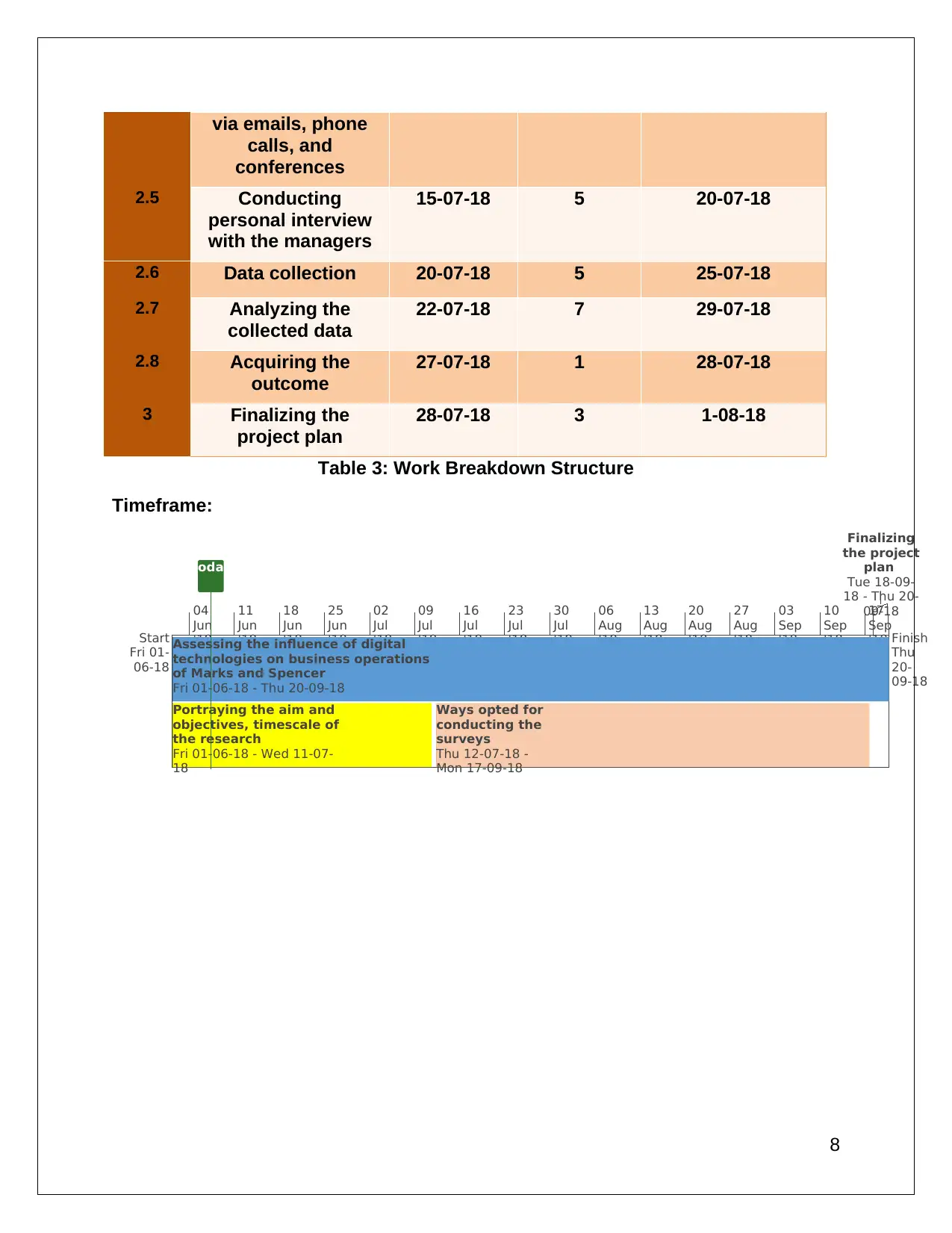
Start
Fri 01-
06-18
Finish
Thu
20-
09-18
04
Jun
'18
11
Jun
'18
18
Jun
'18
25
Jun
'18
02
Jul
'18
09
Jul
'18
16
Jul
'18
23
Jul
'18
30
Jul
'18
06
Aug
'18
13
Aug
'18
20
Aug
'18
27
Aug
'18
03
Sep
'18
10
Sep
'18
17
Sep
'18Assessing the influence of digital
technologies on business operations
of Marks and Spencer
Fri 01-06-18 - Thu 20-09-18
Portraying the aim and
objectives, timescale of
the research
Fri 01-06-18 - Wed 11-07-
18
Ways opted for
conducting the
surveys
Thu 12-07-18 -
Mon 17-09-18
Finalizing
the project
plan
Tue 18-09-
18 - Thu 20-
09-18
Today
via emails, phone
calls, and
conferences
2.5 Conducting
personal interview
with the managers
15-07-18 5 20-07-18
2.6 Data collection 20-07-18 5 25-07-18
2.7 Analyzing the
collected data
22-07-18 7 29-07-18
2.8 Acquiring the
outcome
27-07-18 1 28-07-18
3 Finalizing the
project plan
28-07-18 3 1-08-18
Table 3: Work Breakdown Structure
Timeframe:
8
Fri 01-
06-18
Finish
Thu
20-
09-18
04
Jun
'18
11
Jun
'18
18
Jun
'18
25
Jun
'18
02
Jul
'18
09
Jul
'18
16
Jul
'18
23
Jul
'18
30
Jul
'18
06
Aug
'18
13
Aug
'18
20
Aug
'18
27
Aug
'18
03
Sep
'18
10
Sep
'18
17
Sep
'18Assessing the influence of digital
technologies on business operations
of Marks and Spencer
Fri 01-06-18 - Thu 20-09-18
Portraying the aim and
objectives, timescale of
the research
Fri 01-06-18 - Wed 11-07-
18
Ways opted for
conducting the
surveys
Thu 12-07-18 -
Mon 17-09-18
Finalizing
the project
plan
Tue 18-09-
18 - Thu 20-
09-18
Today
via emails, phone
calls, and
conferences
2.5 Conducting
personal interview
with the managers
15-07-18 5 20-07-18
2.6 Data collection 20-07-18 5 25-07-18
2.7 Analyzing the
collected data
22-07-18 7 29-07-18
2.8 Acquiring the
outcome
27-07-18 1 28-07-18
3 Finalizing the
project plan
28-07-18 3 1-08-18
Table 3: Work Breakdown Structure
Timeframe:
8
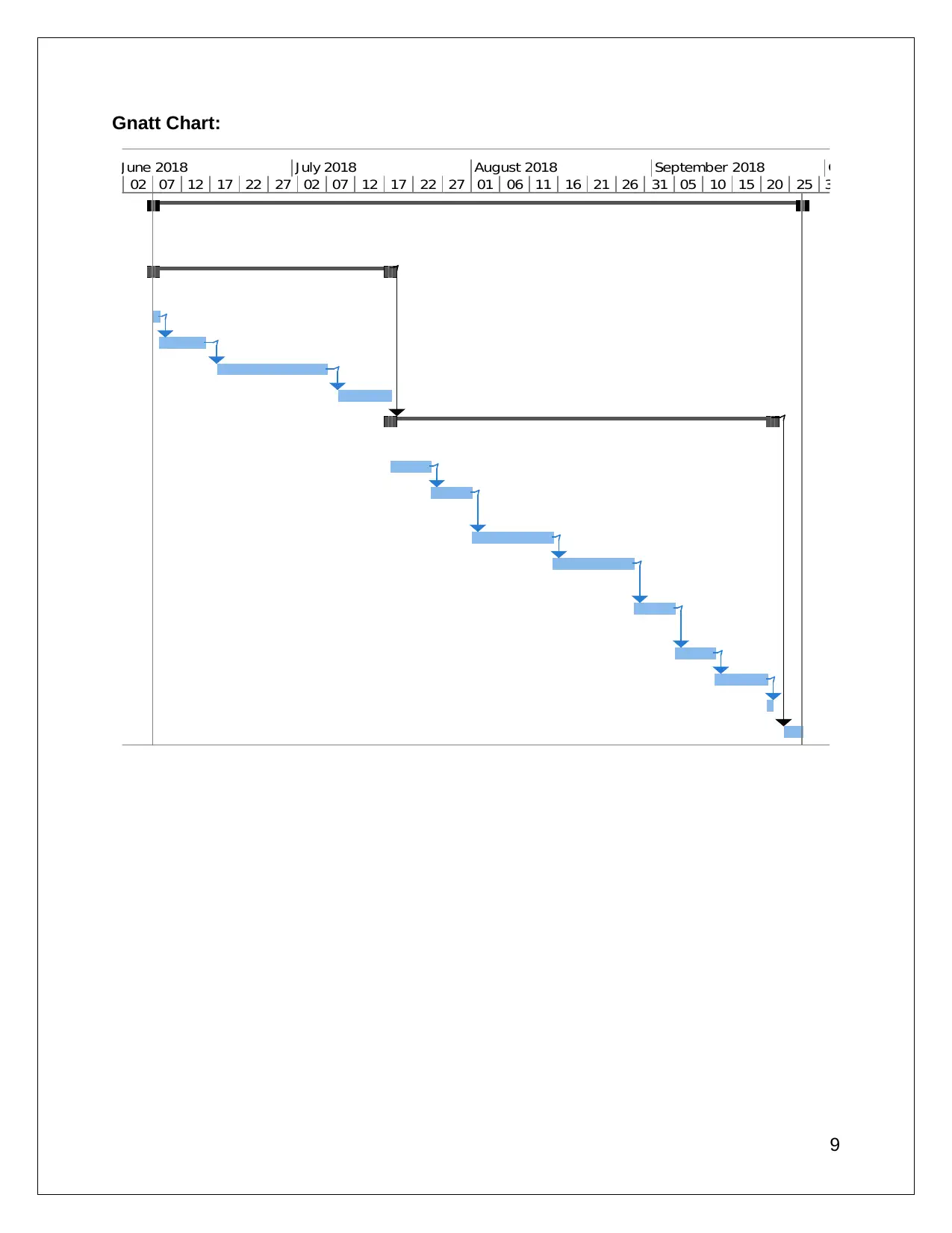
Gnatt Chart:
02 07 12 17 22 27 02 07 12 17 22 27 01 06 11 16 21 26 31 05 10 15 20 25 30
June 2018 July 2018 August 2018 September 2018 October 2018
9
02 07 12 17 22 27 02 07 12 17 22 27 01 06 11 16 21 26 31 05 10 15 20 25 30
June 2018 July 2018 August 2018 September 2018 October 2018
9
⊘ This is a preview!⊘
Do you want full access?
Subscribe today to unlock all pages.

Trusted by 1+ million students worldwide
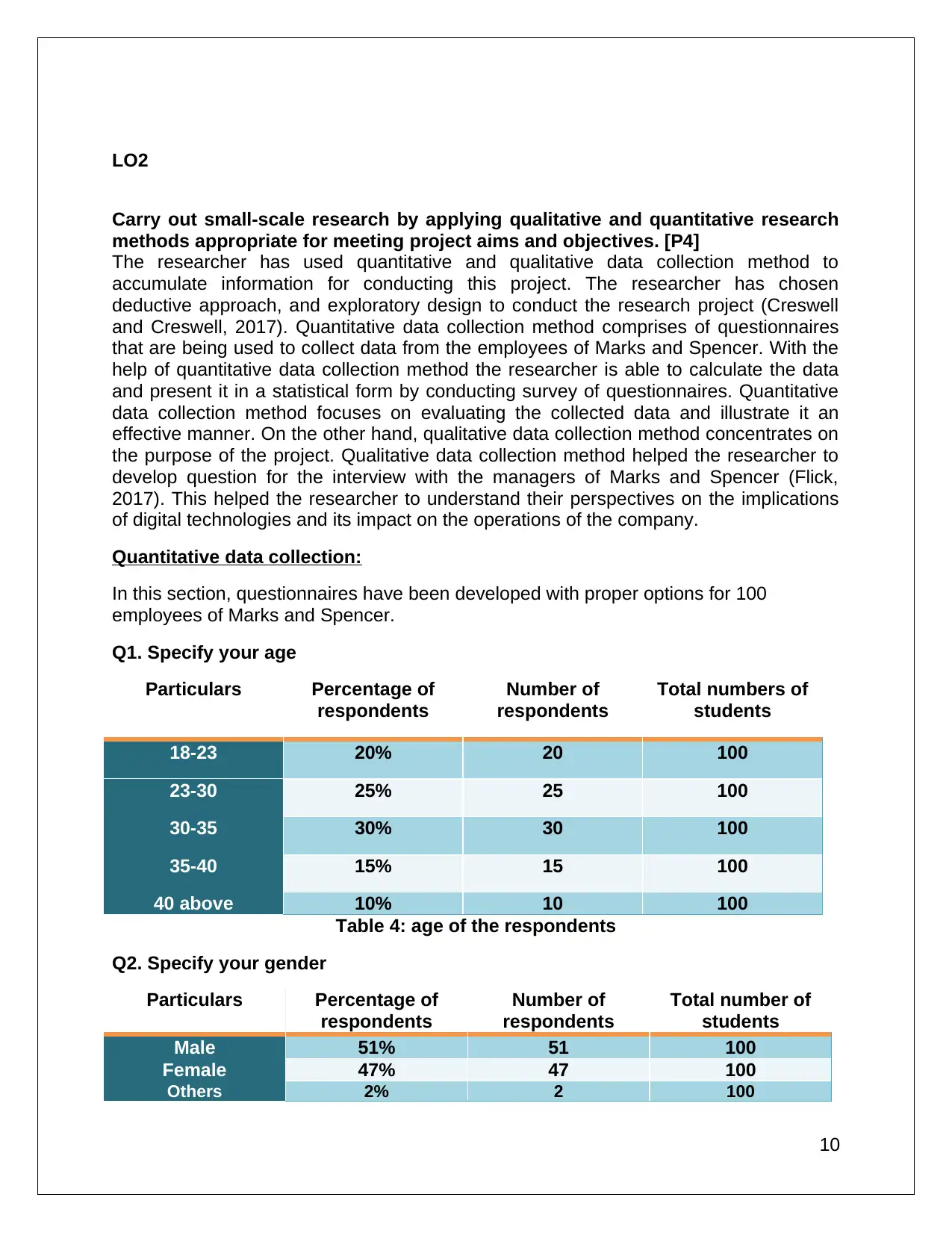
LO2
Carry out small-scale research by applying qualitative and quantitative research
methods appropriate for meeting project aims and objectives. [P4]
The researcher has used quantitative and qualitative data collection method to
accumulate information for conducting this project. The researcher has chosen
deductive approach, and exploratory design to conduct the research project (Creswell
and Creswell, 2017). Quantitative data collection method comprises of questionnaires
that are being used to collect data from the employees of Marks and Spencer. With the
help of quantitative data collection method the researcher is able to calculate the data
and present it in a statistical form by conducting survey of questionnaires. Quantitative
data collection method focuses on evaluating the collected data and illustrate it an
effective manner. On the other hand, qualitative data collection method concentrates on
the purpose of the project. Qualitative data collection method helped the researcher to
develop question for the interview with the managers of Marks and Spencer (Flick,
2017). This helped the researcher to understand their perspectives on the implications
of digital technologies and its impact on the operations of the company.
Quantitative data collection:
In this section, questionnaires have been developed with proper options for 100
employees of Marks and Spencer.
Q1. Specify your age
Particulars Percentage of
respondents
Number of
respondents
Total numbers of
students
18-23 20% 20 100
23-30 25% 25 100
30-35 30% 30 100
35-40 15% 15 100
40 above 10% 10 100
Table 4: age of the respondents
Q2. Specify your gender
Particulars Percentage of
respondents
Number of
respondents
Total number of
students
Male 51% 51 100
Female 47% 47 100
Others 2% 2 100
10
Carry out small-scale research by applying qualitative and quantitative research
methods appropriate for meeting project aims and objectives. [P4]
The researcher has used quantitative and qualitative data collection method to
accumulate information for conducting this project. The researcher has chosen
deductive approach, and exploratory design to conduct the research project (Creswell
and Creswell, 2017). Quantitative data collection method comprises of questionnaires
that are being used to collect data from the employees of Marks and Spencer. With the
help of quantitative data collection method the researcher is able to calculate the data
and present it in a statistical form by conducting survey of questionnaires. Quantitative
data collection method focuses on evaluating the collected data and illustrate it an
effective manner. On the other hand, qualitative data collection method concentrates on
the purpose of the project. Qualitative data collection method helped the researcher to
develop question for the interview with the managers of Marks and Spencer (Flick,
2017). This helped the researcher to understand their perspectives on the implications
of digital technologies and its impact on the operations of the company.
Quantitative data collection:
In this section, questionnaires have been developed with proper options for 100
employees of Marks and Spencer.
Q1. Specify your age
Particulars Percentage of
respondents
Number of
respondents
Total numbers of
students
18-23 20% 20 100
23-30 25% 25 100
30-35 30% 30 100
35-40 15% 15 100
40 above 10% 10 100
Table 4: age of the respondents
Q2. Specify your gender
Particulars Percentage of
respondents
Number of
respondents
Total number of
students
Male 51% 51 100
Female 47% 47 100
Others 2% 2 100
10
Paraphrase This Document
Need a fresh take? Get an instant paraphrase of this document with our AI Paraphraser
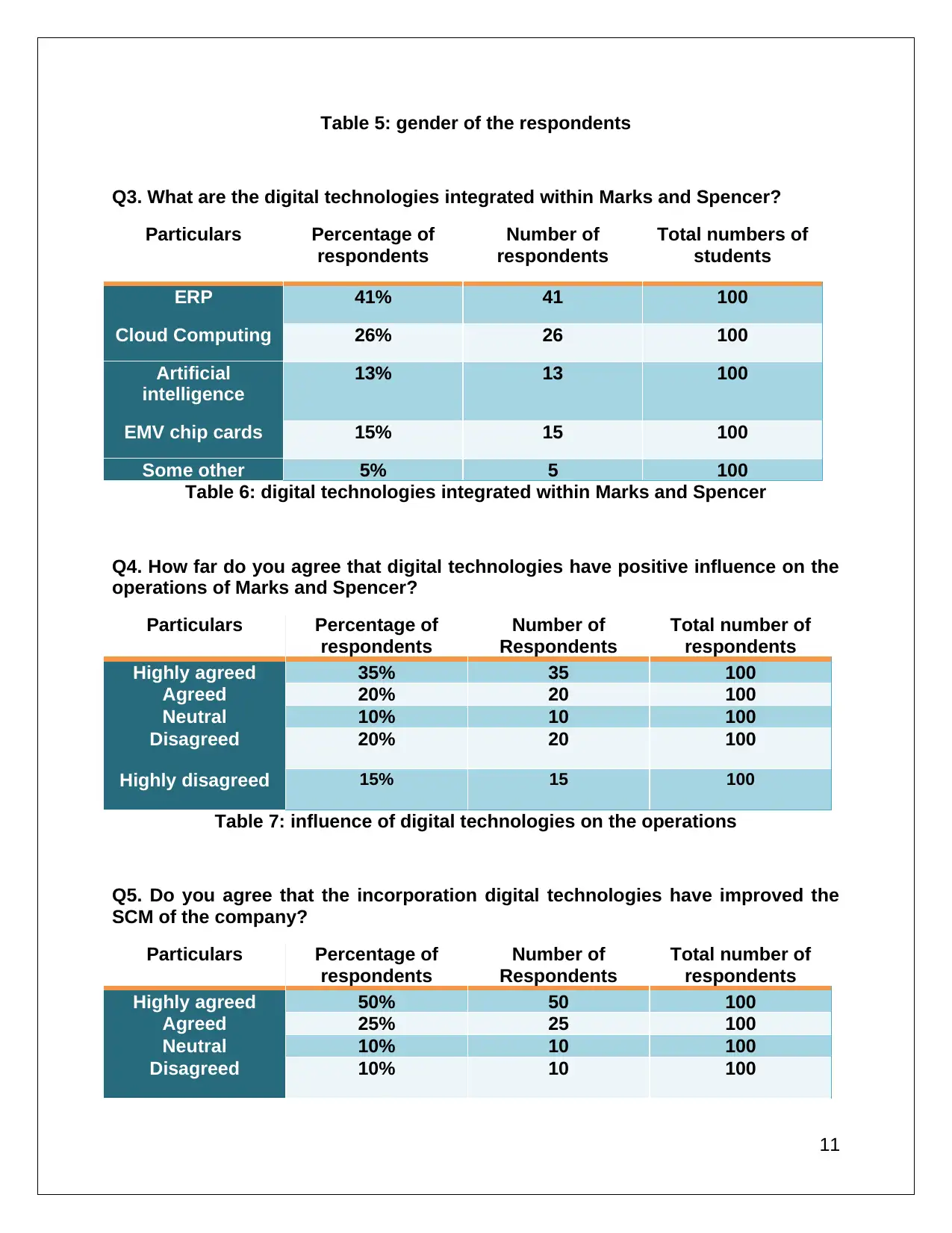
Table 5: gender of the respondents
Q3. What are the digital technologies integrated within Marks and Spencer?
Particulars Percentage of
respondents
Number of
respondents
Total numbers of
students
ERP 41% 41 100
Cloud Computing 26% 26 100
Artificial
intelligence
13% 13 100
EMV chip cards 15% 15 100
Some other 5% 5 100
Table 6: digital technologies integrated within Marks and Spencer
Q4. How far do you agree that digital technologies have positive influence on the
operations of Marks and Spencer?
Particulars Percentage of
respondents
Number of
Respondents
Total number of
respondents
Highly agreed 35% 35 100
Agreed 20% 20 100
Neutral 10% 10 100
Disagreed 20% 20 100
Highly disagreed 15% 15 100
Table 7: influence of digital technologies on the operations
Q5. Do you agree that the incorporation digital technologies have improved the
SCM of the company?
Particulars Percentage of
respondents
Number of
Respondents
Total number of
respondents
Highly agreed 50% 50 100
Agreed 25% 25 100
Neutral 10% 10 100
Disagreed 10% 10 100
11
Q3. What are the digital technologies integrated within Marks and Spencer?
Particulars Percentage of
respondents
Number of
respondents
Total numbers of
students
ERP 41% 41 100
Cloud Computing 26% 26 100
Artificial
intelligence
13% 13 100
EMV chip cards 15% 15 100
Some other 5% 5 100
Table 6: digital technologies integrated within Marks and Spencer
Q4. How far do you agree that digital technologies have positive influence on the
operations of Marks and Spencer?
Particulars Percentage of
respondents
Number of
Respondents
Total number of
respondents
Highly agreed 35% 35 100
Agreed 20% 20 100
Neutral 10% 10 100
Disagreed 20% 20 100
Highly disagreed 15% 15 100
Table 7: influence of digital technologies on the operations
Q5. Do you agree that the incorporation digital technologies have improved the
SCM of the company?
Particulars Percentage of
respondents
Number of
Respondents
Total number of
respondents
Highly agreed 50% 50 100
Agreed 25% 25 100
Neutral 10% 10 100
Disagreed 10% 10 100
11
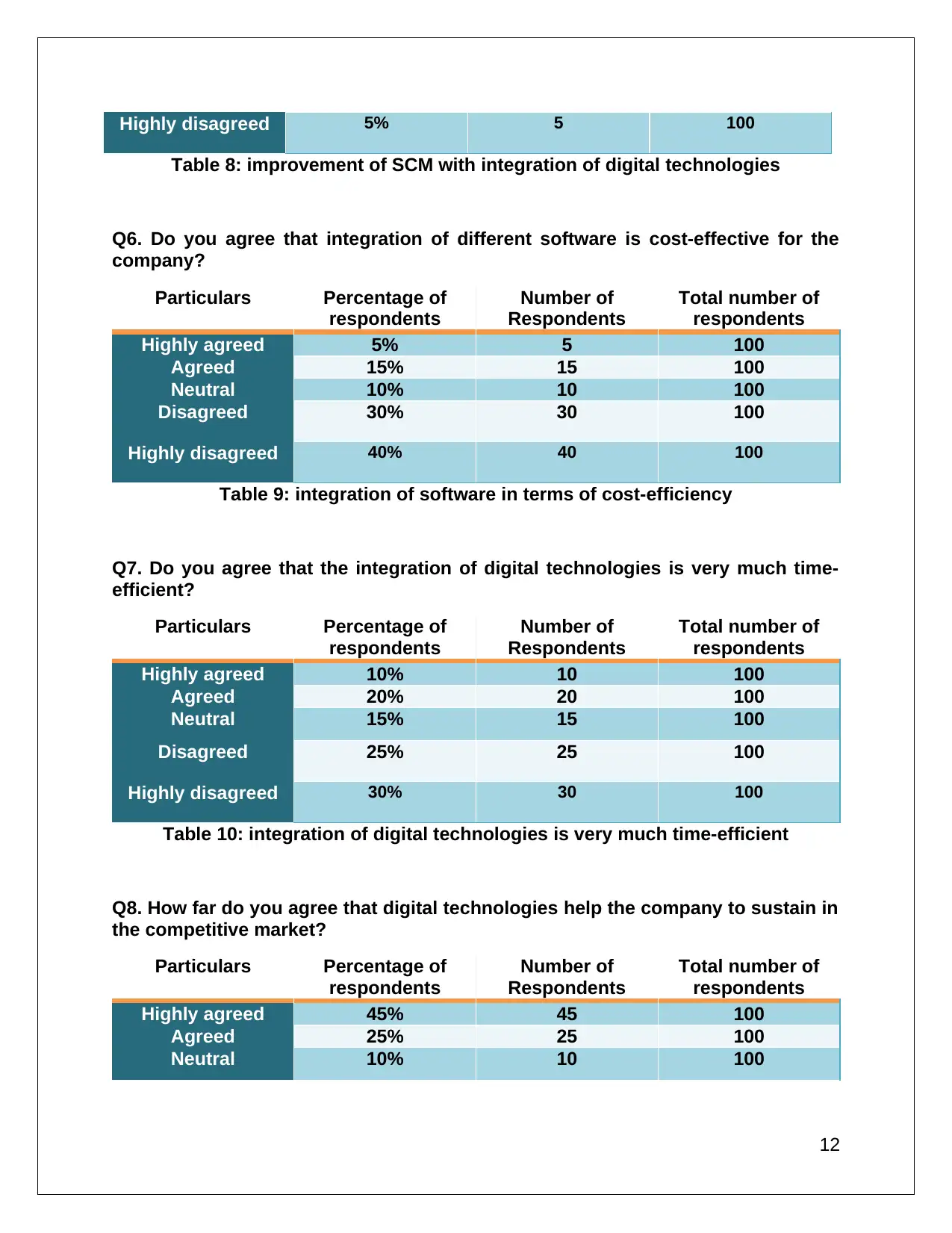
Highly disagreed 5% 5 100
Table 8: improvement of SCM with integration of digital technologies
Q6. Do you agree that integration of different software is cost-effective for the
company?
Particulars Percentage of
respondents
Number of
Respondents
Total number of
respondents
Highly agreed 5% 5 100
Agreed 15% 15 100
Neutral 10% 10 100
Disagreed 30% 30 100
Highly disagreed 40% 40 100
Table 9: integration of software in terms of cost-efficiency
Q7. Do you agree that the integration of digital technologies is very much time-
efficient?
Particulars Percentage of
respondents
Number of
Respondents
Total number of
respondents
Highly agreed 10% 10 100
Agreed 20% 20 100
Neutral 15% 15 100
Disagreed 25% 25 100
Highly disagreed 30% 30 100
Table 10: integration of digital technologies is very much time-efficient
Q8. How far do you agree that digital technologies help the company to sustain in
the competitive market?
Particulars Percentage of
respondents
Number of
Respondents
Total number of
respondents
Highly agreed 45% 45 100
Agreed 25% 25 100
Neutral 10% 10 100
12
Table 8: improvement of SCM with integration of digital technologies
Q6. Do you agree that integration of different software is cost-effective for the
company?
Particulars Percentage of
respondents
Number of
Respondents
Total number of
respondents
Highly agreed 5% 5 100
Agreed 15% 15 100
Neutral 10% 10 100
Disagreed 30% 30 100
Highly disagreed 40% 40 100
Table 9: integration of software in terms of cost-efficiency
Q7. Do you agree that the integration of digital technologies is very much time-
efficient?
Particulars Percentage of
respondents
Number of
Respondents
Total number of
respondents
Highly agreed 10% 10 100
Agreed 20% 20 100
Neutral 15% 15 100
Disagreed 25% 25 100
Highly disagreed 30% 30 100
Table 10: integration of digital technologies is very much time-efficient
Q8. How far do you agree that digital technologies help the company to sustain in
the competitive market?
Particulars Percentage of
respondents
Number of
Respondents
Total number of
respondents
Highly agreed 45% 45 100
Agreed 25% 25 100
Neutral 10% 10 100
12
⊘ This is a preview!⊘
Do you want full access?
Subscribe today to unlock all pages.

Trusted by 1+ million students worldwide
1 out of 28
Related Documents
Your All-in-One AI-Powered Toolkit for Academic Success.
+13062052269
info@desklib.com
Available 24*7 on WhatsApp / Email
![[object Object]](/_next/static/media/star-bottom.7253800d.svg)
Unlock your academic potential
Copyright © 2020–2025 A2Z Services. All Rights Reserved. Developed and managed by ZUCOL.



